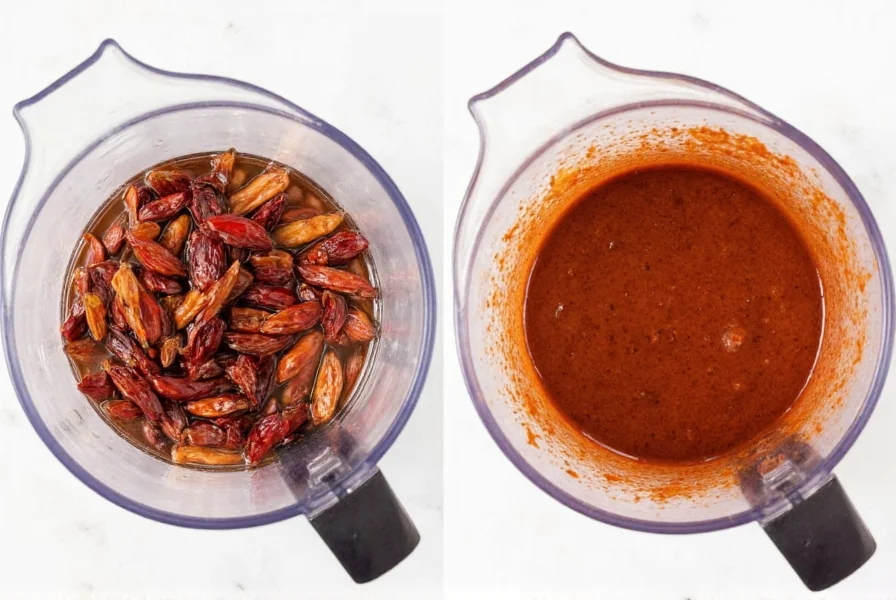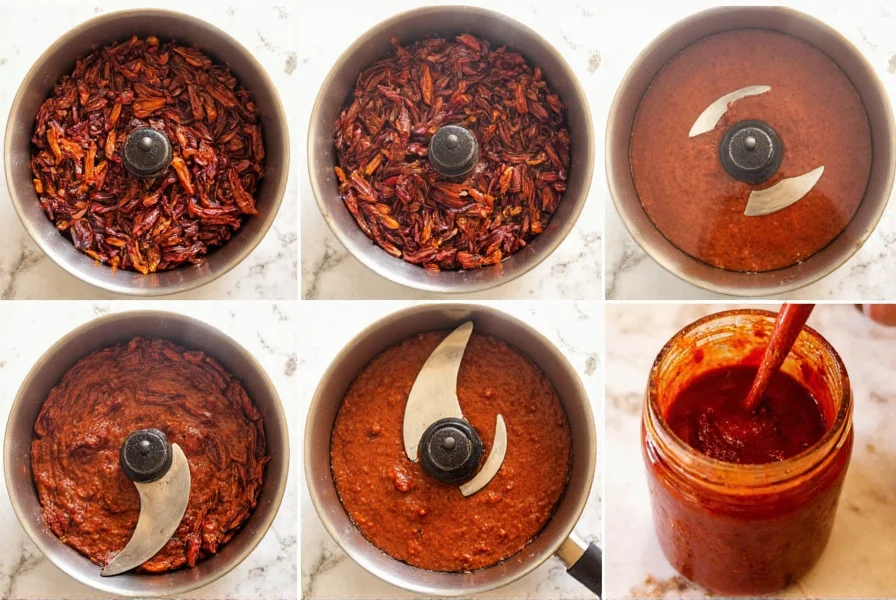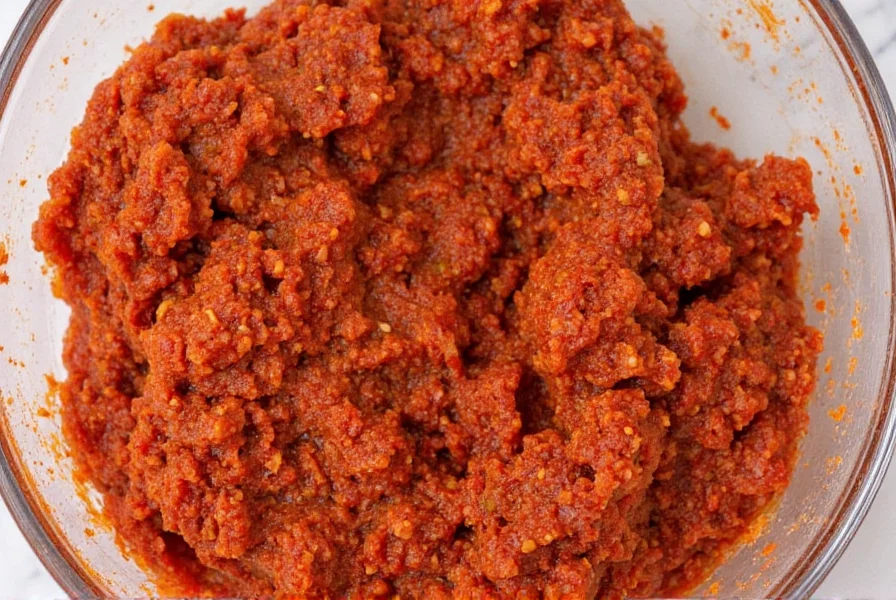Ancho chili paste serves as a foundational element in authentic Mexican cooking, transforming simple ingredients into deeply flavorful dishes. Unlike fresh peppers, the drying process concentrates the natural sugars in poblano peppers, creating a distinctive flavor profile that combines earthy notes with subtle fruitiness. Professional chefs and home cooks alike value this paste for its consistency and ability to blend seamlessly into various preparations without textural disruption.
Understanding Ancho Chilies: The Foundation
Ancho chilies represent the dried form of poblano peppers, harvested at full maturity when they turn from green to deep red. This drying process, typically done through sun-drying or controlled dehydration, triggers enzymatic changes that develop complex flavor compounds. The name "ancho" means "wide" in Spanish, referring to the pepper's broad, heart-shaped form. When properly reconstituted and processed, these chilies yield a smooth paste with remarkable culinary versatility.
| Characteristic | Details |
|---|---|
| Heat Level | Mild to medium (1,000-2,000 Scoville units) |
| Flavor Profile | Smoky, sweet, raisin-like, with earthy undertones |
| Color | Deep mahogany to burgundy |
| Texture | Smooth, thick paste (when properly prepared) |
| Shelf Life | 6 months refrigerated, 1 year frozen |
How Ancho Chili Paste Is Made
Creating authentic ancho chili paste involves several precise steps. First, select plump, flexible ancho chilies with deep color and no cracks. Remove stems and seeds, then soak the chilies in hot water for 20-30 minutes until fully reconstituted. The softened chilies are then blended with complementary ingredients like garlic, cumin, and a touch of acid (typically vinegar or lime juice) to create a smooth emulsion. Some traditional recipes include a small amount of oil to enhance texture and preservation.

Flavor Profile and Culinary Applications
Ancho chili paste delivers a sophisticated flavor profile that distinguishes it from other chili preparations. Its sweetness balances the natural heat, while the smokiness develops from the drying process rather than actual smoke exposure. This complexity makes it invaluable for building flavor layers in dishes where pure heat would be undesirable.
Chefs incorporate ancho chili paste into numerous applications:
- Marinades: Combine with citrus and oil for meats, particularly chicken and pork
- Sauces: Form the base for mole rojo and other complex sauces
- Stews: Add depth to braises and slow-cooked dishes
- Vegetable preparations: Enhance roasted or grilled vegetables
- Breakfast dishes: Incorporate into scrambled eggs or breakfast potatoes
Ancho Chili Paste vs. Similar Products
Understanding the differences between ancho chili paste and related products prevents recipe failures. Chipotle paste, made from smoked jalapeños, delivers significantly more heat and pronounced smokiness. Adobo sauce contains vinegar and spices, creating a tangier profile. Pure ancho powder lacks the moisture content and integrated flavors of properly prepared paste.
When substituting, consider these factors:
- Ancho powder requires additional liquid and may need sweetening to match paste characteristics
- Chipotle paste provides more heat and smokiness—use at half strength
- Guajillo paste offers similar mild heat but with brighter, more acidic notes
Storage and Shelf Life Optimization
Proper storage maintains ancho chili paste's quality and prevents spoilage. Refrigerate commercial paste in its original container for up to six months. For homemade versions, transfer to an airtight container with a thin layer of oil on top to create an oxygen barrier. Freeze in ice cube trays for portioned use, then transfer cubes to freezer bags for up to one year. Always use clean utensils to prevent contamination.
Creating Homemade Ancho Chili Paste
For superior flavor control, prepare ancho chili paste at home with this simple method:
- Remove stems and seeds from 8-10 quality ancho chilies
- Soak in 2 cups hot water with 1 tablespoon vinegar for 25 minutes
- Drain, reserving 1/2 cup soaking liquid
- Blend with 2 garlic cloves, 1 teaspoon cumin, and 1/4 cup oil
- Adjust consistency with reserved liquid until smooth
- Strain through fine mesh sieve for ultra-smooth texture

Recipe Integration Tips
Maximize ancho chili paste's potential with these professional techniques:
- Bloom in oil: Sauté paste in oil before adding liquids to deepen flavors
- Balancing acidity: Counter sweetness with lime juice or vinegar
- Layering heat: Combine with hotter chilies for complex spice profiles
- Texture management: Add early in cooking for integrated flavor, late for brighter notes
Frequently Asked Questions
What is the difference between ancho chili powder and paste?
Ancho chili powder is simply ground dried peppers, while paste includes reconstituted chilies blended with liquid and seasonings. Paste offers immediate usability in wet preparations and more complex flavor integration, whereas powder requires additional liquid and may need sweetening to match paste characteristics.
Can I substitute ancho chili paste in mole recipes?
Yes, ancho chili paste serves as an excellent base for many mole variations, particularly mole rojo. Use 3-4 tablespoons of paste per serving as the foundational element, then build additional complexity with chocolate, spices, and other chili varieties according to your specific recipe requirements.
How spicy is ancho chili paste compared to other chili products?
Ancho chili paste registers between 1,000-2,000 Scoville units, making it significantly milder than chipotle (2,500-8,000) or habanero (100,000-350,000) products. Its heat level resembles mild paprika but with more complex flavor dimensions, allowing for generous use without overwhelming spiciness.
What are the best dishes to feature ancho chili paste?
Ancho chili paste excels in slow-cooked dishes like carnitas, mole sauces, and braised short ribs. It also enhances vegetarian applications such as roasted vegetable medleys, black bean soup, and stuffed peppers. The paste's sweet-smoky profile complements both meat and plant-based proteins without dominating other flavors.
How can I adjust ancho chili paste if it's too spicy?
If your preparation becomes too spicy, balance with equal parts honey or maple syrup and acid (lime juice or vinegar). Dairy products like yogurt or sour cream can also temper heat when serving. For future reference, start with half the recommended amount and gradually increase to achieve your preferred heat level.











 浙公网安备
33010002000092号
浙公网安备
33010002000092号 浙B2-20120091-4
浙B2-20120091-4